But in this profession to which I dedicate myself, if there is a maxim that one must always apply oneself, it is not to pay attention to prejudices, in the same way that one must not pay attention to pressures from the environment and brands. Otherwise, what's the point of testing the car? I remember at a dinner, about four years ago, how the editor of a magazine whose name I'll forget, said out loud "I could write five years of car reviews without even testing them..." in a display of I don't really know what.
But no, folks. That's not how we want to be. So whether it's called Volkswagen Golf R or Tata Indica RRR (three R's, for the sake of giving more emphasis to a hypothetical sporty variant), our approach is always the same: First test and live with it for more than a thousand kilometres, and then give our opinion.
And never has this maxim of first test and then talk proved to be as valid, at least for me, as it is in the case of this Golf R (I know there's one of you, readers, who is already setting up his conspiracy theory of the smeared journalist: resist, my friend, read and have faith in what I'm telling you).
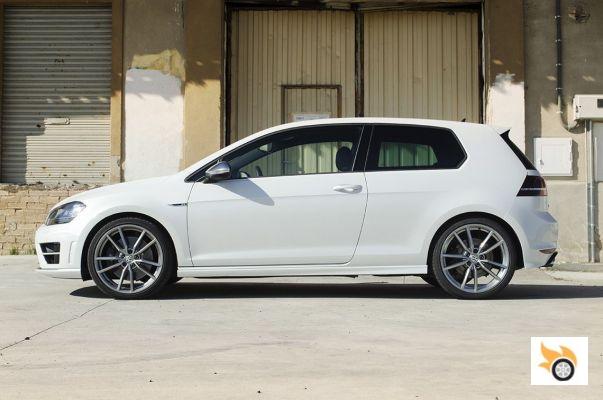
The idea of all-wheel drive with a rear axle that can be connected via a Haldex differential has been around for a long time, but until now it hasn't really convinced us in its response.
We engineers are a strange species, but at the same time we can be divided into two subgroups, for the sake of being even weirder. There are those who seek the engineering of minimalism: achieving the maximum with the minimum. And then there are the engineers who love engineering just for the sake of it, those who over-design and complicate everything to add technical value, which is not always practical, to things.
A professor of mine used to say that the best engineer was not the one who put more tubes in the structure, or the one who made it more complex in its forms to achieve rigidity, but the one who achieved his goal with the minimum expression of material. What in the world of cars we would call "doing a Colin Chapman", you know (and if you don't know who Chapman is, maybe you and I will have to meet at the end of school).
VAG, or rather, Volkswagen as a brand, has always been one of those who do "over-engineering", over-engineering. Excess of technology, which doesn't always automatically convert into a better result in the final product. You know, it's not always better to add more and more ingredients to a beef tenderloin, which is already good with a pinch of salt...
So begins the story of the day when someone at VAG came up with the idea of making the Audi A3. As you well know, by then the Golf's first cousin was going to be the first foray in a long time of the company with the rings in the compact segment (although years before it had made that Polo...). The Ingolstadt had given luster to his signature with all-wheel drive, and to keep it they had to contrive to put all-wheel drive to the A3 transverse front engine. Without looking for over-complications, the decision was to mount a center differential, placed on the rear axle, signed by Háldex.
This solution would also find its place in the Golf R32 (and all Volkswagen 4Motion transverse engine), and on paper proposed an interesting technological alternative. The car was front-wheel drive for most of the time, and only when the system detected a loss of grip on the front axle, it would send torque to the rear axle by means of an electrical signal that reached the differential.
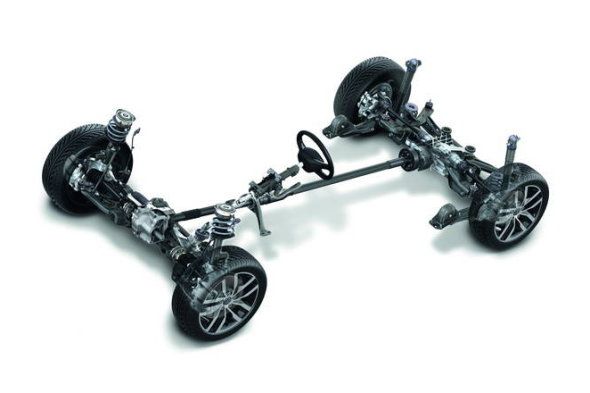
The problem? Sometimes engineers' heads go faster than technological reality, than the state of the art. The first models that integrated this solution had a very obvious problem, and that is that by the time the system sent torque to the rear axle, too much time passed.
The engineers used to measure it in tenths of a second, in wheel spin, to tell you how fast and effective the device was, but although on paper tenths of a second seemed like "nothing", the reality when driving was that the cars didn't behave ideally. From the moment you started not even glimpsing the front axle losing traction until the torque was transferred to the rear axle, your body responded to the loss of trajectory of the car, and it used to try to correct by flattening the throttle, which limited the operation of the Haldex system. If you followed the pedal to the metal but "cracked" when the torque had already reached the rear, the change of traction distribution also had its problems, as the retention also made the car somewhat unpredictable.
So, we can sum up the whole problem in that the engineering solution on paper was ideal, but when it came down to it, the 4Motion systems left a lot to be desired when it came to applying torque from corner to corner successive times.
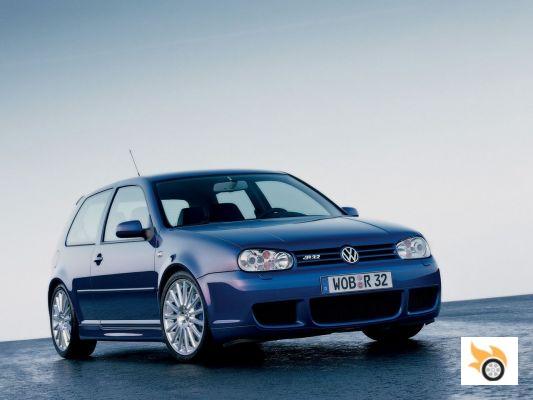
The first R32 was spectacular compared to its peers and sounded great, but dynamically it didn't flow through the corners.
The Golf R32 had other attributes in its favour. It was electric blue, had specific bumpers, wheels and wheel arches. And best of all, it had a VR6 engine that sounded like no current Golf engine. It also had torque in industrial quantities and a full response from bottom to top.
That Golf R32 was great, but it was more of an engine than anything else, its tuning not being up to what the script demanded. The second instalment of the model, coinciding with the fifth evolution of the Golf, deepened that perception that the Golf R was an engine that sounded and pushed great, but it was not to do "curve to curve", but it was "more GT than GTI" in that sense. In fact, I'll tell you that from the fifth generation it was much more fun to make curves with a Golf GTI than with the "erre thirty-two". And that was the first addictive Golf GTI since the second generation...
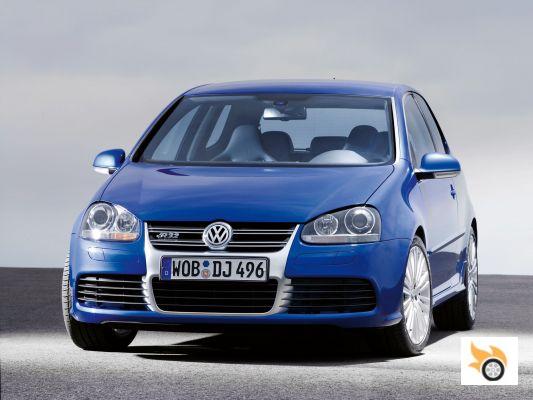
For the sixth generation of the model the VR6 was sacrificed in favour of a boosted 2.0 TFSI variant, but the 4Motion system continued to limit the car's dynamic capabilities. And so we come to the Golf Seven, and the Golf R that concerns us. The firm has come a long way to get here, and on that road is the arrival of the new Haldex all-wheel drive system, the fourth evolution of the rear axle coupling, which, Volkswagen promises, "goes much better than ever". In fact, this same system, employed in the next-generation Audi TT, promises to "enable rear-axle drifts at full power."
But of course, if I wanted to test cars without having to suck up miles, I'd have it easy, I'd transcribe the (brilliantly complete and long) press release and stay at home while I switch to the club of those who brag about "being able to write tests of cars without testing them".
So yeah. After unleashing the WRX STI, I wandered into the building where Volkswagen's Madrid headquarters are located, and went to get the keys to the Golf R to see if what they were saying was true, or if, as I expected, the car was still phenomenally fast on the straights, but not at all entertaining in the corners.
Design
After getting lost in the skyscraper where VAESA is in the capital (don't ask...), I finally managed to get into the car park where I had to pick up the car. Key in hand, you'd think this would be easy, right? But no... it's not.
There were about 25 different Golfs parked in front of my eyes... And at a glance the "erre" didn't shout "I'm here". Believe me: when Ford used to leave you a Focus RS, you knew where it was parked in their press park... This doesn't happen (and they don't want it to happen) with the Golf R.
And the fact is that the units with the optional "erre" finish with bumpers, lowered suspension and wheels look good at first glance. So I turned the key to see where some blinkers were on as I walked from a distance.
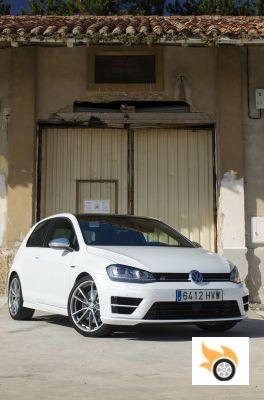
The problem with the Golf R is that it's pretty much the same as a 105hp Golf with R-Line trim.
There it was. White. Almost like any other Golf. Only the rims (optional, by the way), the huge rollers shod on them and the powerful four exhaust tails served to reassure me from the outside that I was looking at the one to brighten up (or not) my week.
This is where part of the public starts to say the usual things: "Hey, it's a Golf" "they're not taking any risks with the design" "they're all the same", and so on and so forth.
When this seventh generation was launched I published a very successful article (I'll leave the "long live me" moment), where I talked about the basics of functionalist design, and how they were applied, point by point, to the Golf.
Volkswagen's compact car has reached the status of a cult object. As such, and like the Porsche 911, every redesign presents a huge challenge. To touch the Golf is to take a risk. If they go too far with it, there will be a legion of fanatics calling for the head designer's head. If they fall short, those who don't buy the Golf will fire up their laptop to show their ongoing discomfort on forums and blogs like this one.
The reality is that the Golf is very dated. After all, it sells almost half a million units a year in Europe, which is a real success. And it's also true that it has changed little from the previous model in its aesthetics, although technologically it has nothing, absolutely nothing to do with it.
But that's part of its undeniable identity: it's a Golf and it has to look like a Golf. So with no roads to go down with risky aesthetic bets, the designers led by Walter de Silva have dedicated themselves to polish and polish a design that, at this point, is close to perfection.
Momento cerros de Úbeda, let me explain: A designer friend of mine once told me that many of the products of the brand he works for and leads are launched on the market with an unpolished design. And the commercial pressures cause the aesthetics to freeze after a few months of work, so that when the car reaches the street, its designers think that it could have been much more polished. Only a few times can you have "unlimited" time and means to mature the product before launching it. And in Volkswagen's case, the designers not only have had that time and those resources, but they also have generations and generations, which are born faster and faster (remember, now the renewal rates are going to be every four or five years for the Golf) to reinforce its DNA.
So, yes, the design at first glance is the same as ever, but it's in the details where you appreciate the quality of it. Especially if you're an engineer, fussy, designer or geek in general.
For example, the front bonnet ribbing is of a radius that you won't see on the sheetmetal of other rival cars, because it takes a very special hot mould stamping to get that bonnet to reproduce the same shape continuously. The styling line or ribbing that runs down the body in a slit-like fashion above the side windows or the ribbing that tightens the sheet metal just parallel to the beltline are other signs of fine design and quality. They are little things that you can notice and waste time discovering (or talking about), or not notice at all but unconsciously realize that, thanks to their existence, the design exudes "timeless quality".

The car exudes quality in the design of each of its details, but is at the same time discreet, with the exception of the four exhaust tails.
But after these phrases of modern functionalist design, I'll tell you that the Golf R especially suffers from what people criticize about the Golf. If a normal Golf no longer attracts attention because... it's a Golf and it's too old-fashioned and too continuist, it's even worse that the Golf R is incapable of making its presence felt. Where the two R32s sang from a distance about their differential character, the current R and its more direct predecessor want to go unnoticed, which they achieve.
In this model not even the rims seem to want to get out of the bodywork... Personally I will tell you that I prefer a car with "more raw" aesthetics, especially when it comes to a beast like the one we have in our hands. But we are dealing with a German brand, with a car designed for people who can spend 45.000€ in a Volkswagen compact... And of course, that Germanic customer profile usually has other tastes.
Cabin
A good friend of mine, a professor and research engineer (yes, he has a Golf), rode the "erre" while I had it at home, and told me "it's like any other Golf... even the controls". And yes, that's the feeling. You open the car and you notice the distinction: LEDs light up all over the cabin to illuminate the footwell, blue strips light up on the door trim, and the steering wheel is specific, with three spokes, with the bottom one having a "erre" inscribed in its hole. But the rest of the interior is conventional "pure Golf". Yes, there are blue needles, and some particularly good seats to tuck your body into, but nothing jumps out at you or gets your adrenaline pumping before you even start the car.
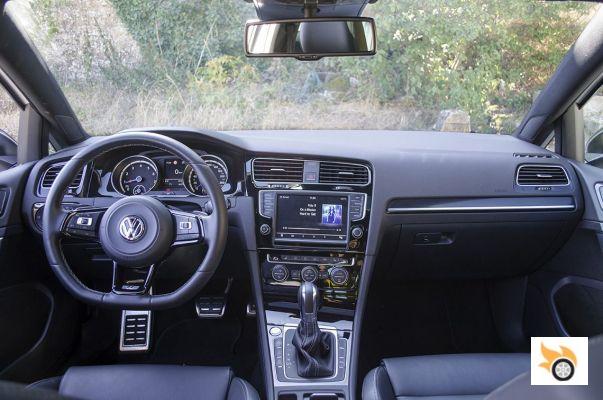
The interior is not racing, but it is finished with first class materials and fittings. Ergonomically it is the reference of the segment
Materials? Fit? Design? It's a Golf, and you can go back over previous tests and genuine contact with the seventh generation of this model, but I'll stick with telling you that, for me, it's still the absolute benchmark in all those respects in its segment.
Finding the right driving position is extremely easy. In fact, you feel right at home after touching the controls (manual in a £45,000 car), sitting close to the floor, with your legs slightly extended and the steering wheel falling comfortably with your arms slightly bent. As rally driver doctrine dictates.
The rear seats aren't the biggest in the class, and the boot isn't exactly spacious. I will tell you that, in fact, and after forgetting for a while how it was (we test so many cars that sometimes you lose the references) I was surprised to have to dismantle the wheels of my child's chair to put it in the trunk one of the days I had to move with the little Nadia around the city. Few compact cars have these problems, and part of the space in the boot is taken up by the full-size spare wheel.
Don't panic, don't panic. I'm not saying it has little boot or rear seats, but if those are your priorities then maybe you're not looking for an "erre" (and you'd be better off with a 308, which wins on those two counts).
Urban Movement
Back to the driver's seat. Finger to the ignition button and the TFSI comes to life with a very pleasant and, why not say it, surprising purr. Why the surprise? It's clear that it doesn't sound and I didn't expect it to sound like a six-cylinder R32, but this Golf R manages to make, with its four exhaust tails, that the sound emanating from it already tells us "something".
A quick look around, I put it in reverse, and aided by the rear view camera and the parking assistance system, I pull the car out of the garage comfortably. There's nothing here unlike any other Golf.
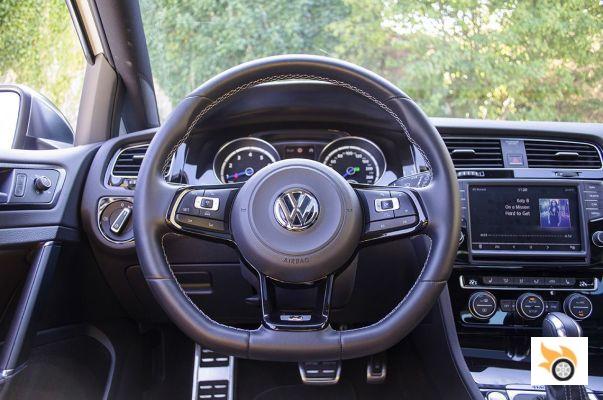
In the city it is comfortable with the suspension in its most relaxed mode, it uses little fuel... it is as versatile as a Golf TDI.
I get in a few miles of city driving in all sorts of conditions before I go looking to tickle its fancy. Running errands back and forth, I find the suspension surprisingly capable of swallowing speed bumps at 50 mph in full comfort, something that would make you think you're looking at a much softer sprung car than the "erre" has on it. The stiffness of the chassis, the silentblocks used in the subframes and the active dampers that contain the spring bounce make this the most street-worthy 300-horsepower car I've had recently.
In the past, active damping technology didn't achieve such differentiated settings as this Golf does, which also leaves the springs free to compress and extend quickly over specific bumps, but without giving them a chance to rebound, by changing the setting in tenths of a second to suit the needs.
The sound system is great, although it doesn't quite match the nuances of the WRX STI's Harman Kardon, but the Golf R wins by a landslide in isolating you from the elements: It's not noisy, and if you're driving relaxed you'll barely notice the engine doing its share of the work.
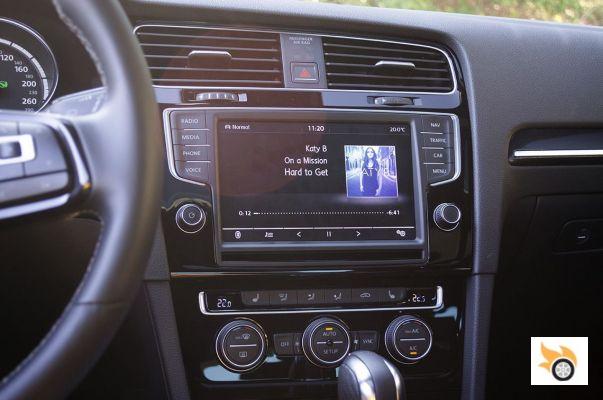
On top of that, it's capable of getting about the same fuel economy as a Golf GTI, around eight and a half litres per 100, which leaves you shocked: can 300 horsepower really be that unthirsty in the city, or did the STI just leave me scarred by its consumption there?
With the exception of the connoisseurs and the enervated (for giving something to the gas more than the account and thunder them), the rest of passers-by do not turn their heads once to look at the Golf R that blends in with its surroundings.
Action
This car is so good in the city that it must have something hidden, I think. Convinced that it will do strange things in the power transfer, and that with such an absorbent suspension it will have problems to manage its horsepower, I put on my boots and go to attack my favourite mountain pass route. My perception of Volkswagen is about to change for life. I press the button to select the "Race" mode, which among many other settings changes the damper settings, and put the DSG in manual mode.
Full throttle and the 300 horses seem to be much, much more. The response to the accelerator is immediate. There's no lag at all. The engine's delivery? Forceful from the lowest part of the rev counter until it stretches to around seven thousand revs before you have to engage another gear. True, maximum power is reached at 6,200, but the engine is still capable of stretching a little further if you want it to if you don't want to go into another gear before you start braking for a corner.
It runs. It runs a lot.
Shifts are quasi-instantaneous between pressing the cam and achieving the gear change, which is seconded by the engine's pitch change when changing engine speed. Thrust, on the other hand, barely hints at any change: the car keeps pushing you while the seats grip you.
At very illegal and improper speeds, I approach a very round ninety-degree curve that looks almost like a roundabout. I brake on entry, take off gears, the power of the rigid calipers is there, and Volkswagen has managed to remove some of the excess servo assistance it applies to its brake pedals, even if they're still not "the most dosable" thing in the world.
At this point I remember that my friend Maxi Cortés (yes, the driver) had told me that the car could be a bit playful from the rear if it had Continental tyres. I'm wearing Bridgestone, and it brakes stiffer than a candle, with no sign of doing anything weird.
Wanting to provoke and get my inner self out of doubts quickly, who still thinks that "no matter how much four-track and shit, it will never be like an M235i", I put the steering wheel all the way down to play with the inertia and look for the throttle almost immediately. Will it be able to yaw the rear?
Yes, amazing, but if you give it even more throttle, it can even maintain that yaw a little bit!
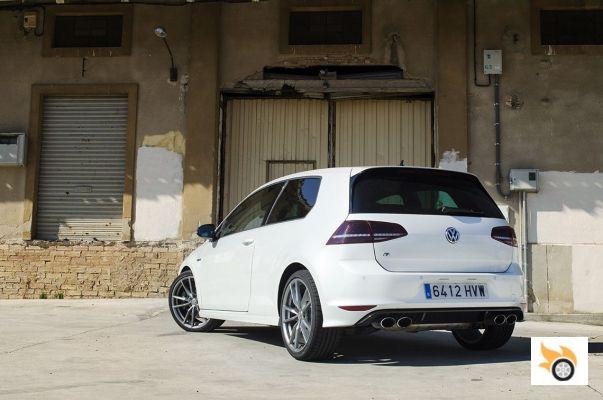
This is like watching your child take his first steps: You've seen him try a thousand times without succeeding. You feel desperation, but one day he succeeds, and happiness overcomes you. And that's what Volkswagen engineers must feel, after years, decades working with the 4Motion system, they have finally managed to make it do what their press releases have been saying for decades (this would lead us to consider the veracity of all the press releases of all the brands, but we'll laugh about that another day in another report, I'm lost...). Let's not go too far: it won't do an epic skid with the car crossed at 45º from the tangent to the corner, but it will yaw just enough to round the line.
The first surprise is to see how the all-wheel drive system is able to respond just as we've been told it would for years, sending torque to the rear axle just when you need it.
After that "eureka" moment of the first corner, and with a strange smile on my face, I concentrate on... concentrating, to dissect the car's behaviour in the next set of corners that await me, which come in all colours and flavours.
So, how's it going? In a slow corner, coming from a fast straight, there's plenty of braking power and stability until you decide to put the nose in. The car doesn't pitch under braking, but perhaps more importantly, it also doesn't roll or combine both vices when you throw the wheel into the apex. A big part of the achievement lies in the control the dampers have over the body, which allows them to maintain a stiff spring by restraining the rate of movement of the springy elements. You notice how there is little polar moment of inertia, because the car takes "nothing and less" to lean into the corner in a frank manner.
The steering has just the right weight, impeccable precision without blemish, but... zero information. It has variable gear ratio as standard, a trend that already floods its rivals (the M235i also has it this way). Personally I think the integration of these systems is a good idea, although Dani doesn't see it as clear as I do. It doesn't feel artificial like in other electrics, and in fact it's very pleasant and natural in its self-centering effects, but, as I say, if you expect it to lighten up when you lose the front end, forget it, because it won't tell you. They say that the typical customer prefers it that way... I'm clearly not the typical customer. And it's also clear that the fact of mounting a variable gear system makes it almost impossible to get any information from the wheels to the steering wheel rim.
If, once supported, you want to close the trajectory because you go long, the rear will not collaborate to the cause, as it is "welded" to the asphalt, and the only way to move it is to play with excessive inertias. But I will tell you that, unless you make a huge mistake, it will be difficult to go long, because the brakes act on the inside wheels of the curve to play with a vectoring effect that closes the car to the line we set with the steering wheel.
From a car that didn't flow when cornering, we've moved on to a much more efficient machine that doesn't get clumsy when we're pushing the limits.
With the car at the apex of the corner, putting all the power to the ground is child's play. You press the throttle and not a single horsepower screeches through the wheels. What torque there is is converted into thrust in a way you wouldn't expect. And it does so without the steering wheel playing in your hands: There are no parasitic effects on the steering. If you get stubborn, unlike previous 4Motions, this one is capable of yawing its arse off, as I explained above, on pure power.
If that slow corner gets tangled up with another corner in another direction or braking in support, the car will still surprise you. Changes of direction happen almost instantaneously. Having good ingredients (low center of gravity, reduced polar moment of inertia and super stiff monocoque) makes that, without having a hard suspension and helped by the aforementioned magnetorheological shock absorbers, the car feels like a fish in water playing in changes of direction or braking in support without us taking the nose dragging at every moment. It is surreal the change that this represents with respect to the R32 and the previous Golf R.
Best of all, track, wheelbase and stability mean that as the road opens up and the corners unravel and get faster and faster, the solidity of the lines make the Golf R a spectacular car in its cornering, and also in the breathtaking ease with which it negotiates each turn.
In the past, you had to go to practically straight roads to get the most out of the Golf R, but not any more. Now it can eat a Burger King or prepare a foamy smoke on a bed of Adriatic figs.
And if the tarmac is broken? It brings out its superb damping, and devours potholes without disturbing the line. That's the magic of active damping suspensions, when they work really well. Of course, a well-tuned passive damper suspension can achieve the same results if properly tuned for a particular surface, but the play that an active system gives in adapting to different road surfaces opens up a lot of the car's malleability when it comes to ground engagement. In this sense, the Golf's choice of settings seems more accurate than Audi's, which always seems drier and rougher.
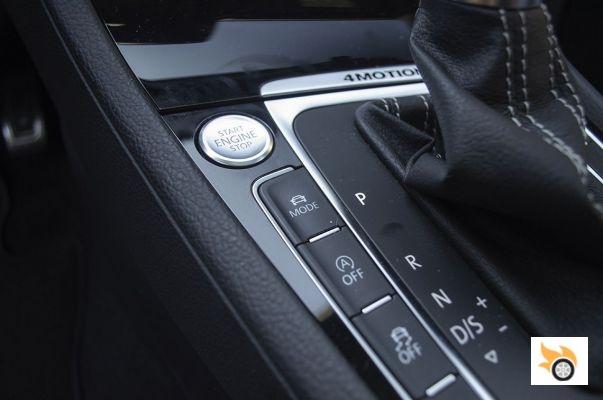
The problem for the most passionate is that it's not a car that gives you a direct connection to the road. You don't feel it. It's not boring or clumsy and it's addictive, but not in the traditional old school GTI way.
It's true: there are cars that transmit more, cars that challenge you, that are more difficult to drive fast, or that make you feel the road. But that doesn't stop the Golf R, in its own way, from becoming not only effective, but addictive. It's a real hook, and so is the mechanical soundtrack. It makes everything easy, yes, but that doesn't make it any less interesting.
An M235i, my favourite car tested this year, probably has the advantage of having a more "winkable" rear end, but it's also less suited to playing with curly tarmac, while its nose doesn't bite as well on corner entry.
The problem with the Golf R is a personal and conceptual one. We're so used to praising any car that makes us feel the road and enjoy it. As with the S3, the Golf R fails in that perhaps, because it filters out much of that information, in favour of the feeling of safety. As a friend of mine who works as a tuning engineer for a brand confessed to me, "they ask us to make cars feel safe, and that means filtering everything". That's how you get to that moment when you're driving through corners with the Golf R at a pace that an Evo VII couldn't keep up with, but you do it without feeling like you're on a knife's edge.
It was that feeling of going with a knife between your teeth that injected adrenaline into your veins. The one that made you thrill, make your hair stand on end and bring a smile to your face. With the Golf R you can achieve satisfaction, but not along those lines. It's a car you fall in love with because of the dominant G-forces. Because of the sheer acceleration and the great cornering. But it never comes across as a playful car that you feel the pebbles and gravel through your hindquarters as you're skidding from behind in full support on the gas.
To travel long distances
You might expect that after gaining so much in twisty road handling, some of the long-distance comfort would be lost, but it's not. The Golf R is still a devourer of motorways, dual carriageways and country roads.
The engine, as you can imagine, won't be. It goes a long way, and doesn't swallow much if you don't push the right pedal. If you have to drive at night, the bi-xenon headlights with automatic long headlights that create shadows so as not to dazzle the vehicles that cross your path are another technical marvel.
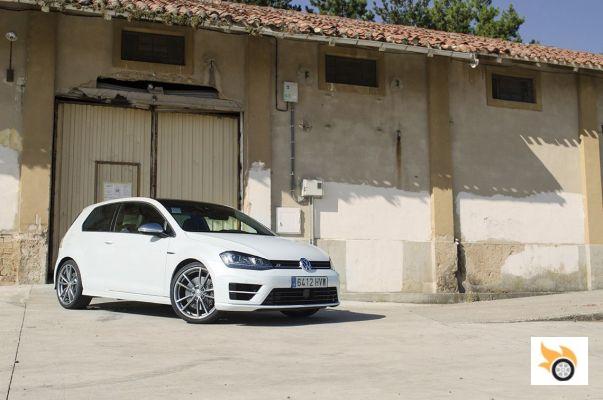
The same goes for the active cruise control with lane keeping assist, a solution that makes road trips safer and easier. Yes, it's optional equipment, included in the version tested, but we're talking about options that can't even be requested in most general compact cars, which puts the Golf R in the premium league. Even among them, the Golf R manages to stand out, not only for the equipment, but for how they work. And it's not just that it has this or that element, it's that they work in this car.
So yes, if the size of the boot isn't a problem for you, in all other respects the Golf R is a real joy-chaser with which you can travel to the end of the world without getting tired.
Conclusions
And by now, after all the compliments and compliments I've paid it, you'd think I desperately want a Golf R, and I'll buy one. I can't deny that it's a car I've loved. But I switch off the engine, open the door, leave the cosy interior and... when I get out of the car and look at it, I say "there's something wrong here".
And it's not, as I said above, because the Golf R is an ugly car. Far from it. But it doesn't say anything to me. I'm not passionate about looking at it.
It has a lot of good things about it. And even for me, who would need five doors, I could objectively consider it the complete and total car. As a good Golf, it's good at everything, or almost everything. But it lacks that visual swagger, that athletic display on the outside of what it hides on the inside.
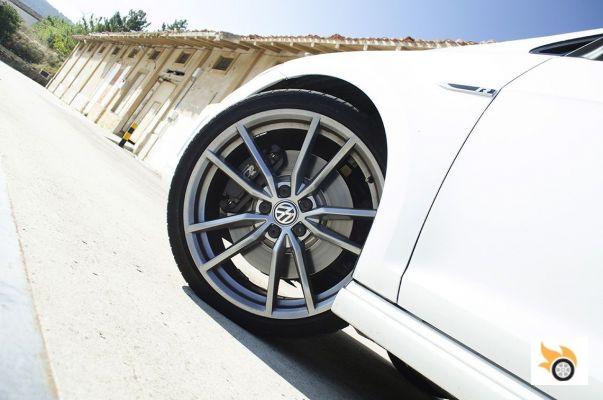
It's the Golf plus Golf: it's the total car. It's fast, it's versatile, and it's just as good for a mountain pass as it is for a holiday in Florence and a drive through the streets.
And now, shall we place it in the market? On the one hand we have its German rivals. The M235i is, for me, my favourite choice. At the same price and practically the same performance, it is only available as a coupe, it is more expensive to fully equip, has a less successful interior design (yes, although it sounds surreal), and does not have all-wheel drive (a plus for those who live in places where traveling on snow is something that happens to us 20 times a year).
Audi's S3 is a twin cousin so close in every way that it should be ridiculous to compare the two. But the reality is different. Where the S3, as Dani told you when he tested it, is efficient and fast, but at the same time, inert and lacking in sensation transmission, the Golf manages to excite us more. Not because it makes you feel the road more, but because you can play more with its behaviour and make it turn on itself. Also, the Golf's suspension feels more suited to the actual state of any given road than its Audi sibling.
The A45 AMG will still have to go through a lengthy test before we can give an in-depth opinion on it, and the M135i five-door, which should be the more direct rival within BMW (rather than the M235i) we've had written off for a while now "for being ugly", although if the current 1 Series appeals to you, rest assured that this is a more interactive option than the Volks.
If we go off the beaten Germanic premium paths, the only rival we can think of is the WRX STI, but it's as different as comparing tomatoes with cows... Where the Subbie is old school radical group A, archaic, greedy but also passionate, the Volkswagen is effectiveness, speed, contained consumption and technical solutions at the forefront.
In the end, and to sum it all up in a few words, the Golf R can be summed up as the triumph, at last, of engineering. Of ideas. At last the all-wheel drive system achieves what we were promised: sending torque to the axle that needs it, at the instant it needs it, without you being able to practically notice it.
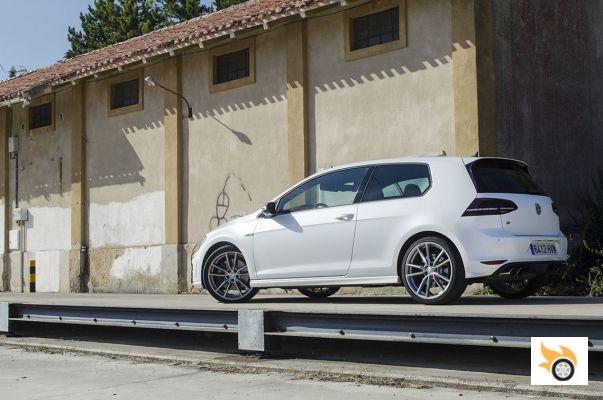
The great achievement is that, for the first time, it's fun to drive a Golf R around corners. Personally, I'd rather buy a green Focus RS, but it's clear that I'm not the right customer, even though I think the Golf R is spectacular.
That, along with all the other technological equipment that can be fitted to this car, is the great achievement of the Golf R, which is being billed as the "ultimate premium Golf".
Its problems? None that you don't already know about: The steering doesn't talk to you, you can't feel the road going to the limit, and the aesthetics won't make you tear your clothes off for it or turn your head. Some will be able to rise above those shortcomings and look past them to the stunning car at hand. Others, myself included, will irrationally continue to prefer the likes of the second-generation Focus RS. Fast, barbaric, less effective, less well equipped and finished and more expensive. But believe me, all these crazy people who are scattered around the world, if we are able to forget for a moment the aesthetic and sensation prejudices, we will end up admiring the Golf R to travel fast and enjoy pure speed. It will be a matter of having a sensation machine in the garage to make up for it.
Article originally published in September 2014, retrieved for Pistonudos
























